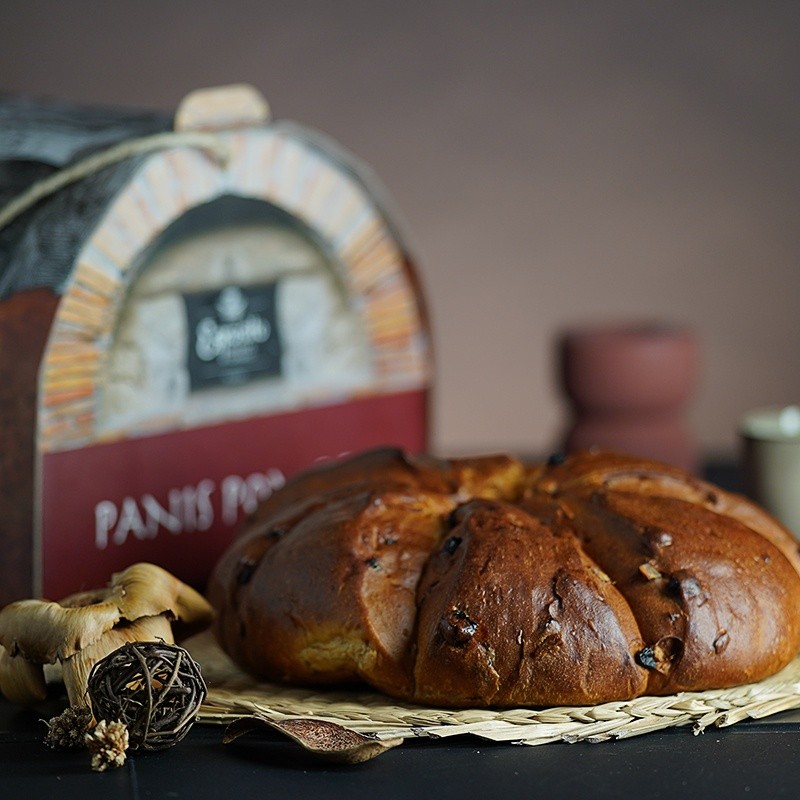





Panis Pompeii is a sweet bread, ancestor of "Panettone", inspired by an ancient Roman recipe, it is the bread that was produced in ancient Pompeii, destined for the wealthy of the time.
Preservative free product
This is a fresh, handmade product. Please allow 72 hours for your order to be processed.
Soft wheat flour type 0; [ancient wheat flours (24%) (spelt (wheat); spelt dicocco (wheat); spelt monococco (wheat)]; natural baking powder; noble milk, fresh butter, fresh eggs, honey, walnuts from the Sorrento peninsula, dried figs, sultanas from the Vesuvian hills, candied fruit from the Sorrento peninsula, aniseed, cinnamon.
The 'Panis Pompeii', also called 'Panis Quadratus', represents an interesting aspect of daily life in ancient Rome, particularly linked to the city of Pompeii. This type of bread, known for its distinctive shape, is one of the most emblematic foods found in the archaeological excavations of Pompeii, preserved under volcanic ash after the eruption of Vesuvius in 79 AD.
The Panis Pompeii, or Panis Quadratus, was a round bread characterised by engravings that divided it into eight sections. These incisions not only made it easier to divide the bread, but also reflected Roman culinary ingenuity and adaptability. The name 'Quadratus' does not refer to the square shape, as one might think, but rather to the four lines used to create the eight sections on its surface. This bread was a staple of the Roman diet, which was based on the so-called Mediterranean triad: cereals (bread), olives (olive oil) and wine. Research suggests that there were around 30 bakeries in Pompeii alone, each of which must have produced a considerable amount of bread. In 1862, during archaeological excavations in one of the bakeries, 81 large loaves of bread were found, ready to be sold on the day of the eruption.
It may interest you
Panis Pompeii is a sweet bread, the forerunner of the world-famous Panettone, which is now found in every European home at Christmas time.
A bread for the rich, to be served at sumptuous banquets, rich in precious ingredients of great quality and authenticity: honey, walnuts from the Sorrento peninsula, dried figs, sultanas and aniseed.
An authentic Panis Pompeii (sweet bread) is characterised by the leavening process; the yeast used is an ancestor of today's baker's yeast.
In ancient Pompeii, there were more than 30 bakeries that produced bread kneaded with water, wheat flour and sourdough for festivities and special occasions, or for the tables of the Pompeian nobility, where the bread, whether sweet or savoury, was enriched with fine ingredients:
Today, the art of Pompeii baking lives on through the production of 'Panis Pompeii', which is made in an artisan bakery that is the heir to a long family tradition. This bread, characterised by its octagonal shape, is the result of careful research and experimentation inspired by the ancient bread of Pompeii. The ingredients used, such as honey, figs, milk, walnuts and aniseed, contribute to its uniqueness and link it to the culinary traditions of the past. The mastery of baking and the use of genuine ingredients reflect a deep respect for tradition, combined with a commitment to quality and authenticity. As well as celebrating the culinary heritage of Pompeii, this bread is an example of how historical heritage can inspire innovation and creativity in the modern time.
Panis Pompeii can be enjoyed on its own or, as the ancient Pompeians did, with a drizzle of honey. Discover our collection of artisan honeys.